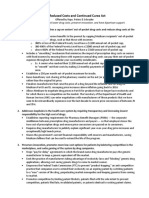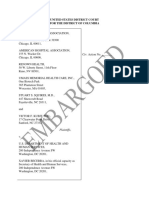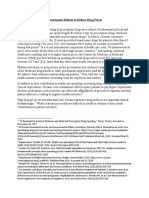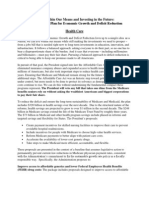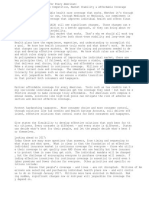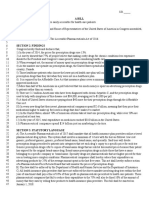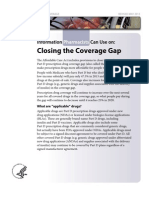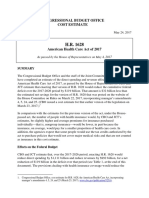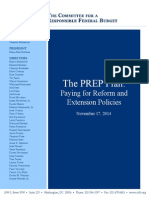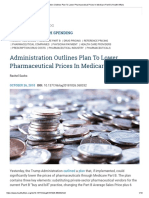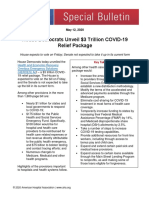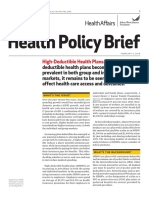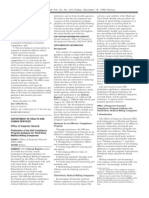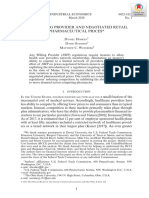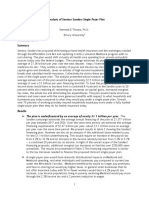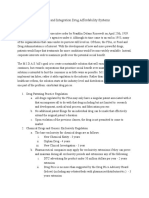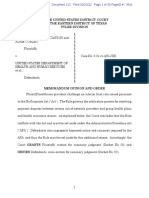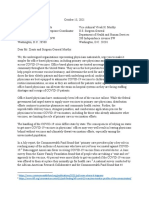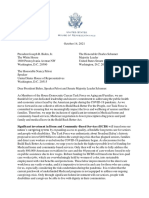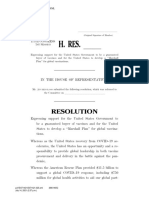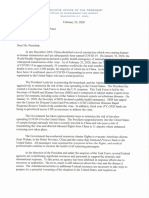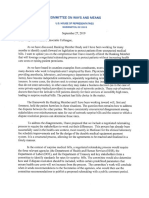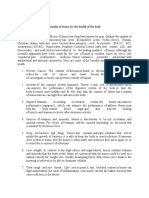Professional Documents
Culture Documents
Drug Pricing High Level Overview - 11-2
Uploaded by
Peter SullivanOriginal Title
Copyright
Available Formats
Share this document
Did you find this document useful?
Is this content inappropriate?
Report this DocumentCopyright:
Available Formats
Drug Pricing High Level Overview - 11-2
Uploaded by
Peter SullivanCopyright:
Available Formats
Prescription Drug Pricing
Below is an overview of the agreement on prescription drugs. The policy is structured around three main
provisions:
1. Providing the authority, the mandate, and the tools for Medicare to negotiate drug prices outside
their initial exclusivity period.
2. Redesigning the Part D benefit to protect seniors from high out-of-pocket spending.
3. Instituting rebates for drug prices that grow faster than inflation.
Negotiation: Under this policy, Medicare will negotiate prices for a subset of drugs. The process begins
with the Secretary of HHS selecting from a list of the highest gross spending drugs in each of the Part B
and Part D programs that are single source drugs outside of their initial exclusivity periods – 9 years for
small molecule drugs and 12 years for biologics – as well as insulin products.
The proposal specifies that the Secretary will negotiate up to 10 drugs for 2025. In each following year,
that number will increase until reaching up to 20 drugs for 2028 and beyond. CMS indicated that those
numbers are feasible.
After selecting the drugs for negotiation, manufacturers will submit information about the selected drug,
such as their research & development costs, prior federal financial support, extent to which the drug
addresses an unmet need, whether the drug represents a therapeutic advance beyond existing treatments,
and more. The Secretary then uses this information to engage in a back and forth with the manufacturer
to arrive at an agreed to fair price. During this process, the Secretary is explicitly directed to consider the
innovation that the selected drug represents.
The negotiated price cannot exceed the following:
75% of its 2021 non-federal average manufacturer price for a small molecule drug fewer than 12
years but more than 9 years passed initial exclusivity.
65% of its 2021 non-federal average manufacturer price for a drug 12 – 16 years passed initial
exclusivity.
40% of its 2021 non-federal average manufacturer price for a drug more than 16 years passed
initial exclusivity.
For manufacturers that refuse to negotiate, they will be subject to an excise tax; however, CBO assumes
this tax is never actually levied.
When the Secretary and manufacturer arrive at an agreed to negotiated price, the Secretary will then
require that the negotiated drug be carried on the formulary by all Part D plans so that all patients have
access to it.
Inflation Rebates: The base year for the inflation rebate is 2021. The rebate is calculated based on total
drug units sold.
Part D Redesign: The policy creates an annual out-of-pocket patient spending cap of $2,000, and
allows those costs to be smoothed over the calendar year. Insulin co-pays are capped at $35 per month.
In addition, the beneficiary share of costs in the initial coverage phase will be decreased from the current
25%; lawmakers will include a placeholder reduction and work expeditiously to finalize a design to
1
You might also like
- Blackstone Response To House Committee On Energy and Commerce-2Document7 pagesBlackstone Response To House Committee On Energy and Commerce-2Peter SullivanNo ratings yet
- PBM Revenue Streams Lack TransparencyDocument4 pagesPBM Revenue Streams Lack Transparencyapi-165632810No ratings yet
- National COVID-19 Preparedness PlanDocument96 pagesNational COVID-19 Preparedness PlanPeter SullivanNo ratings yet
- Capstone Research Project - PGDM3921Document38 pagesCapstone Research Project - PGDM3921Ronak SinghNo ratings yet
- Cycloplegic Refraction in Optometric Practice 1337594763401 2Document14 pagesCycloplegic Refraction in Optometric Practice 1337594763401 2Strauss de LangeNo ratings yet
- Medicare Part DDocument2 pagesMedicare Part DArnold VenturesNo ratings yet
- Peters, Schrader RCCCA - One PagerDocument1 pagePeters, Schrader RCCCA - One PagerPeter SullivanNo ratings yet
- REMS Abuse and The CREATES ActDocument2 pagesREMS Abuse and The CREATES ActArnold VenturesNo ratings yet
- AMA and AHA - Complaint 12 9 2021 Embargoed VersionDocument29 pagesAMA and AHA - Complaint 12 9 2021 Embargoed VersionPeter SullivanNo ratings yet
- Patient Education schiZOphreniaDocument2 pagesPatient Education schiZOphreniarinkai13100% (1)
- Swot Analysis MabDocument4 pagesSwot Analysis MabparasmanishaNo ratings yet
- Medicare Part BDocument2 pagesMedicare Part BArnold VenturesNo ratings yet
- Pharmaceuticals Executive SummaryDocument10 pagesPharmaceuticals Executive SummaryPradyot78No ratings yet
- Medicaid: Health Policy BriefDocument2 pagesMedicaid: Health Policy BriefArnold VenturesNo ratings yet
- Drug Policy ProposalDocument10 pagesDrug Policy ProposalClay SpenceNo ratings yet
- Fact Sheet - Health Care - FINALDocument6 pagesFact Sheet - Health Care - FINALsarahkliffNo ratings yet
- Policy Memo - JFullerDocument4 pagesPolicy Memo - JFullerJuliaNo ratings yet
- AHIPDocument5 pagesAHIPPeter SullivanNo ratings yet
- Billcreator HealthcarereformDocument1 pageBillcreator Healthcarereformapi-336537386No ratings yet
- 2020 National Drug Control Strategy Performance Reporting SystemDocument30 pages2020 National Drug Control Strategy Performance Reporting SystemMedicinal ColoradoNo ratings yet
- Managed Care NPRM 09 2015Document3 pagesManaged Care NPRM 09 2015api-293754603No ratings yet
- Cost Sharing MotDocument9 pagesCost Sharing MotCommittee For a Responsible Federal BudgetNo ratings yet
- Privatizing Medicaid in ColoradoDocument7 pagesPrivatizing Medicaid in ColoradoIndependence InstituteNo ratings yet
- Mac Guineas Testimony Medicare Reform 12oct11Document12 pagesMac Guineas Testimony Medicare Reform 12oct11Committee For a Responsible Federal BudgetNo ratings yet
- 11522-p Closing The Coverage GapDocument8 pages11522-p Closing The Coverage GapJames LindonNo ratings yet
- HR 1628 As PassedDocument41 pagesHR 1628 As PassedCNBC.comNo ratings yet
- Hwang Health Care Cost Growth 10 ProfilesDocument38 pagesHwang Health Care Cost Growth 10 ProfilesBruhan KaggwaNo ratings yet
- Prepplan PDFDocument12 pagesPrepplan PDFCommittee For a Responsible Federal BudgetNo ratings yet
- Administration Outlines Plan To Lower Pharmaceutical Prices in Medicare Part B - Health AffairsDocument10 pagesAdministration Outlines Plan To Lower Pharmaceutical Prices in Medicare Part B - Health AffairsLeroy RogersNo ratings yet
- Public Finance NotesDocument2 pagesPublic Finance NotesThea KocirajNo ratings yet
- AHASpecialBulletin House3Trillion FinalDocument5 pagesAHASpecialBulletin House3Trillion FinalJohnNo ratings yet
- GPOs - Gaming The System 2018Document5 pagesGPOs - Gaming The System 2018Greg FNo ratings yet
- HCRprovisions - Older Adults 3-30-10Document6 pagesHCRprovisions - Older Adults 3-30-10hcreformNo ratings yet
- Us Health Reform Alertv6Document12 pagesUs Health Reform Alertv6Roman TilahunNo ratings yet
- Cost Control in Health Care......................................Document11 pagesCost Control in Health Care......................................Rifat ParveenNo ratings yet
- Arnold Ventures IRA Excise Tax Comment LetterDocument3 pagesArnold Ventures IRA Excise Tax Comment LetterArnold VenturesNo ratings yet
- High Deductible Health PlansDocument6 pagesHigh Deductible Health PlansiggybauNo ratings yet
- Healthcare Reform TimelineDocument16 pagesHealthcare Reform TimelinenfibNo ratings yet
- OIG Compliance Program For Third-Party Medical Billing CompaniesDocument15 pagesOIG Compliance Program For Third-Party Medical Billing CompaniesaaronborosNo ratings yet
- The Next Steps For Medicare Reform, Cato Policy AnalysisDocument24 pagesThe Next Steps For Medicare Reform, Cato Policy AnalysisCato InstituteNo ratings yet
- Overlapping Policies and Estimated Savings Across Fiscal PlansDocument12 pagesOverlapping Policies and Estimated Savings Across Fiscal PlansCommittee For a Responsible Federal BudgetNo ratings yet
- Medicare Prescription Drugs: Medical Necessity Meets Fiscal Insanity Cato Briefing Paper No. 91Document12 pagesMedicare Prescription Drugs: Medical Necessity Meets Fiscal Insanity Cato Briefing Paper No. 91Cato InstituteNo ratings yet
- State Health Exchanges and Qualified Health PlansDocument49 pagesState Health Exchanges and Qualified Health PlansRajiv GargNo ratings yet
- Health System Reform Short SummaryDocument11 pagesHealth System Reform Short SummarySteve LevineNo ratings yet
- Cau2 - Any Willing Provider Negotiate Retail Pharmacetical PriceDocument39 pagesCau2 - Any Willing Provider Negotiate Retail Pharmacetical PriceNhật An Nguyễn ThịNo ratings yet
- Maryland Health Care Reform PlanDocument7 pagesMaryland Health Care Reform PlanEddie O'BrienNo ratings yet
- Kenneth Thorpe's Analysis of Bernie Sanders's Single-Payer Proposal.Document7 pagesKenneth Thorpe's Analysis of Bernie Sanders's Single-Payer Proposal.Dylan Matthews57% (7)
- Current Events 3Document2 pagesCurrent Events 3api-101202183No ratings yet
- Draft Hiring Incentives To Restore Employment (HIRE)Document4 pagesDraft Hiring Incentives To Restore Employment (HIRE)api-25909546No ratings yet
- Bennet-Kaine Medicare-X Choice Act SummaryDocument1 pageBennet-Kaine Medicare-X Choice Act SummaryU.S. Senator Michael F. BennetNo ratings yet
- An Analysis of Access To Anticonvulsants in Medicare Part D and Commercial Health Insurance PlansDocument18 pagesAn Analysis of Access To Anticonvulsants in Medicare Part D and Commercial Health Insurance PlansAlexNo ratings yet
- Strategic Management Assignment (Est) : Regulatory FrameworksDocument4 pagesStrategic Management Assignment (Est) : Regulatory FrameworksIshaan KumarNo ratings yet
- Opioid Settlement Fund Advisory Board ReportDocument652 pagesOpioid Settlement Fund Advisory Board ReportCapitol PressroomNo ratings yet
- Health Insurance GlossaryDocument13 pagesHealth Insurance GlossaryvivekNo ratings yet
- HHS Report Aug 09Document43 pagesHHS Report Aug 09nchc-scribdNo ratings yet
- International Drug Price Comparisons Review of Pharmaceutical Price Regulation: National Policies Versus Global InterestsDocument9 pagesInternational Drug Price Comparisons Review of Pharmaceutical Price Regulation: National Policies Versus Global InterestsAJHSSR JournalNo ratings yet
- The HMO Act of 1973 Health Maintenance Organization Act of 1973Document3 pagesThe HMO Act of 1973 Health Maintenance Organization Act of 1973Sai PrabhuNo ratings yet
- CBO Score: American Health Care Act (AHCA)Document37 pagesCBO Score: American Health Care Act (AHCA)Breitbart News100% (1)
- Options Memo - Nikhil Taurani - DraftDocument2 pagesOptions Memo - Nikhil Taurani - DraftnikheltauraniNo ratings yet
- Overlapping Policies and Estimated Savings Across Fiscal PlansDocument13 pagesOverlapping Policies and Estimated Savings Across Fiscal PlansCommittee For a Responsible Federal BudgetNo ratings yet
- An Analysis of Health Insurance Premiums Under The Patient Protection and Affordable Care ActDocument29 pagesAn Analysis of Health Insurance Premiums Under The Patient Protection and Affordable Care ActKFFHealthNewsNo ratings yet
- Team B Fsa ProposalDocument3 pagesTeam B Fsa Proposalapi-617684065No ratings yet
- Remarks by Administrator Seema Verma at The Biopharma CongressDocument6 pagesRemarks by Administrator Seema Verma at The Biopharma CongressAlexNo ratings yet
- Spending Cap: ($10.4 B) ($4.3 B) ($2.6 B) ($7.1 B) ($5.1 B) ($1.9 B)Document6 pagesSpending Cap: ($10.4 B) ($4.3 B) ($2.6 B) ($7.1 B) ($5.1 B) ($1.9 B)tvanootNo ratings yet
- Summary, Analysis & Review of Philip Moeller’s Get What’s Yours for MedicareFrom EverandSummary, Analysis & Review of Philip Moeller’s Get What’s Yours for MedicareNo ratings yet
- Textbook of Urgent Care Management: Chapter 22, Health Plan ContractingFrom EverandTextbook of Urgent Care Management: Chapter 22, Health Plan ContractingNo ratings yet
- Governor Letter Arp Aptc - Final 062822Document3 pagesGovernor Letter Arp Aptc - Final 062822Peter SullivanNo ratings yet
- 2022-02-23 Memorandum Opinion (DCKT 113 - 0)Document35 pages2022-02-23 Memorandum Opinion (DCKT 113 - 0)Peter SullivanNo ratings yet
- Multi-Member Letter On RX Prices 1.31.22Document4 pagesMulti-Member Letter On RX Prices 1.31.22Peter SullivanNo ratings yet
- Frontliner Letter On Lowering Health Care Costs in Reconciliation - 5.23.22Document4 pagesFrontliner Letter On Lowering Health Care Costs in Reconciliation - 5.23.22Peter SullivanNo ratings yet
- EoDocument3 pagesEoPeter SullivanNo ratings yet
- Org Letter To Administration On COVID Vaccines10-12Document2 pagesOrg Letter To Administration On COVID Vaccines10-12Peter SullivanNo ratings yet
- Significant Investment in Home and Community-Based Services (HCBS) Will Transform OurDocument2 pagesSignificant Investment in Home and Community-Based Services (HCBS) Will Transform OurPeter SullivanNo ratings yet
- H. RES. LL: ResolutionDocument4 pagesH. RES. LL: ResolutionPeter SullivanNo ratings yet
- HR 19 Letter (2228)Document2 pagesHR 19 Letter (2228)Peter SullivanNo ratings yet
- JG To W&M E&C Re BBB MedicareDocument2 pagesJG To W&M E&C Re BBB MedicarePeter SullivanNo ratings yet
- Letter To PelosiDocument2 pagesLetter To PelosiPeter SullivanNo ratings yet
- Coronavirus Congressional LetterDocument2 pagesCoronavirus Congressional LetterPeter SullivanNo ratings yet
- Medicare Physician Fee Schedule Letter - SignedDocument4 pagesMedicare Physician Fee Schedule Letter - SignedPeter SullivanNo ratings yet
- 2020-12-15 Letter To Congressional Leadership Re Surprise Billing FinalDocument3 pages2020-12-15 Letter To Congressional Leadership Re Surprise Billing FinalPeter SullivanNo ratings yet
- RSC S Surprise Medical Billing Backgrounder.02Document8 pagesRSC S Surprise Medical Billing Backgrounder.02Peter SullivanNo ratings yet
- ML 2020-051Document3 pagesML 2020-051Peter SullivanNo ratings yet
- Edu GROUP Funding Letter 040620 FINALDocument3 pagesEdu GROUP Funding Letter 040620 FINALPeter SullivanNo ratings yet
- AFL-CIO Letter SurpriseBillingDocument2 pagesAFL-CIO Letter SurpriseBillingPeter SullivanNo ratings yet
- JCT LetterDocument1 pageJCT LetterPeter SullivanNo ratings yet
- Coronavirus Supplemental Request Letter FinalDocument3 pagesCoronavirus Supplemental Request Letter FinalPeter SullivanNo ratings yet
- House Democratic Caucus Task Force On Aging and Families LTR To Biden Harris Transition - Geriatrician To COVID Advisory BoardDocument2 pagesHouse Democratic Caucus Task Force On Aging and Families LTR To Biden Harris Transition - Geriatrician To COVID Advisory BoardPeter SullivanNo ratings yet
- LHCC Section by Section FINALDocument16 pagesLHCC Section by Section FINALPeter SullivanNo ratings yet
- HR3 TitleI&II MemoDocument16 pagesHR3 TitleI&II MemoPeter SullivanNo ratings yet
- Doggett Dear ColleagueDocument2 pagesDoggett Dear ColleaguePeter SullivanNo ratings yet
- Neal Surprise BillingDocument2 pagesNeal Surprise BillingPeter SullivanNo ratings yet
- Res 1Document10 pagesRes 1Claire Dean SarmientoNo ratings yet
- Product Mix AssignmentDocument25 pagesProduct Mix AssignmentRishabh Gupta0% (1)
- Healthcare Consultant 5yr ExpDocument4 pagesHealthcare Consultant 5yr ExpsunilroutNo ratings yet
- Tata 100307Document17 pagesTata 100307api-3773208No ratings yet
- Project Customer Relationship ManagementDocument81 pagesProject Customer Relationship Managementgoutam50% (2)
- Rational Drug Use National Action Plan 2014-2017Document20 pagesRational Drug Use National Action Plan 2014-2017elmin_pctNo ratings yet
- Massachusetts Life Sciences Super ClusterDocument3 pagesMassachusetts Life Sciences Super ClusternancyjlevyNo ratings yet
- Digital Marketing For Pharma IndustryDocument6 pagesDigital Marketing For Pharma IndustryKumar Anshul100% (1)
- Comhealth Lec 1Document24 pagesComhealth Lec 1Kiana SanchezNo ratings yet
- Abbott 2010Document118 pagesAbbott 2010t behaNo ratings yet
- Clinical Trials Information System - Sponsor HandbookDocument37 pagesClinical Trials Information System - Sponsor HandbookarvanitisdimitrisNo ratings yet
- 18 Biggest Problems With Modern MedicineDocument2 pages18 Biggest Problems With Modern MedicineAli LaldinNo ratings yet
- GSK Annual Report 2018 PDFDocument161 pagesGSK Annual Report 2018 PDFSana MerajNo ratings yet
- Indonesia Pharma Market 2022Document16 pagesIndonesia Pharma Market 2022DeepNo ratings yet
- Paper 1-1Document14 pagesPaper 1-1Musa Maingu100% (1)
- Pharmacy Technician LawsDocument2 pagesPharmacy Technician LawsGene'sNo ratings yet
- Plan of ActivitiesDocument5 pagesPlan of ActivitiesShaileene SheignNo ratings yet
- Pharmacy Practice Sample ReportDocument26 pagesPharmacy Practice Sample Reportsaransh misraNo ratings yet
- B.pharmacy Time Table June 2010Document7 pagesB.pharmacy Time Table June 2010jntuforumNo ratings yet
- Dr. Amal. Role of MSOpdfDocument44 pagesDr. Amal. Role of MSOpdfmariaNo ratings yet
- EMA Draft GuidelineDocument34 pagesEMA Draft Guidelinesakib445No ratings yet
- LPU-CAVITE - Tamayo, Rowen Alexander M - Module 5Document3 pagesLPU-CAVITE - Tamayo, Rowen Alexander M - Module 5alexis tamayoNo ratings yet
- Cciv Civil Law Internal Moot Court Problems 5 Years B.A.,LL.B - A Semester XDocument8 pagesCciv Civil Law Internal Moot Court Problems 5 Years B.A.,LL.B - A Semester X165Y064 OM KISHORE KUMAR NNo ratings yet
- HimalayaDocument23 pagesHimalayaRamesh Chandra Pal100% (1)
- Benefits of Honey For The Health of The BodyDocument1 pageBenefits of Honey For The Health of The BodytiaraputriyaminNo ratings yet
- Boquecosa Nursing Review ReviewerDocument19 pagesBoquecosa Nursing Review ReviewerElay PedrosoNo ratings yet






